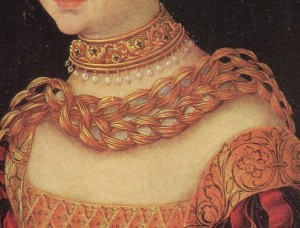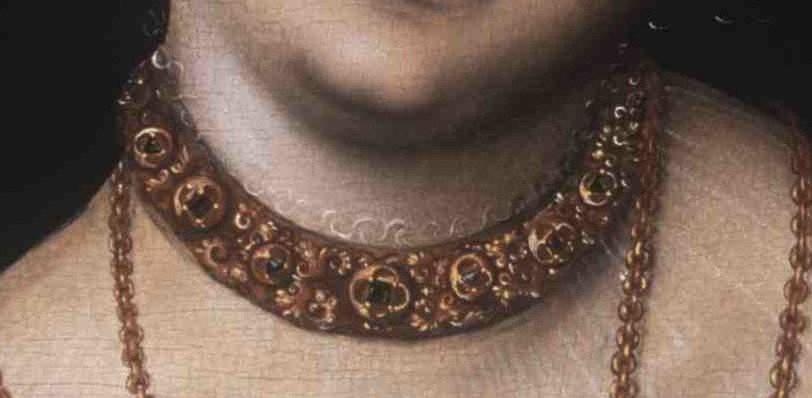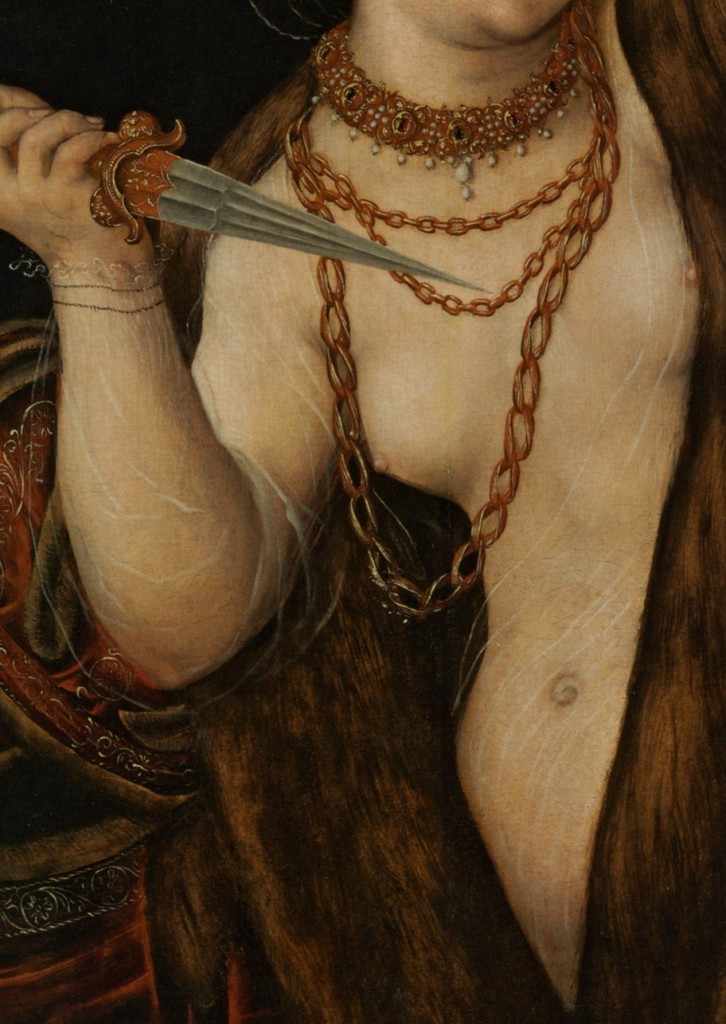In my review of German renaissance paintings of women, I’ve seen many upper class ladies with lovely beaded chokers around their necks. I took these chokers first to be jewelry.
Later, I noticed that some of these chokers appeared with a fine, translucent material that covered the bare skin between the top of a gown and the neck.
Closer looks revealed that these were not so much chokers but possibly bands into which this material was pleated. And then I realized … these could be high-necked garments, made of a fine material and pleated into a beaded and possibly jeweled neckband. For the purposes of my research, I am calling these Halshemd (Hals = neck, hemd = shirt).
It’s interesting that sometimes the pleats of the Halshemd are painted, and sometimes not. My theory is that the tiny, translucent pleats were challenging to reproduce, and painters sometimes chose not to paint them. It’s also possible that the choice of a translucent material meant that these garments were intended to be “invisible” (in the way modern bras can have “invisible” straps) and thus were not included in the image.
I’m not clear on is the length of the Halshemd. Are they short, like gollers or partlets, or long, like an underdress? The material is so fine that I’m inclined to think they are short, as it seems impractical to have such a fine material next to your skin that would need to be laundered regularly. But when you look carefully at the neckline of the gowns worn by the women, you can see no other garment showing besides the Halshemd. And, one nude shows the Halshemd, and it clearly has sleeves and is not goller-length.
The above painting may be misleading, however, as you cannot see any material near the neck or chains. Did the painter chose not to paint the folds of the Halshemd there so that the other details were clearer, or was the garment open in some manner? It’s also entirely possible that this painting does not reflect reality, and is rather a fantasy of the painter’s imagination. And, on the flip side, it could be evidence that the chokers were separate from the Halshemd (if you click the image to enlarge it, you can see she has a bracelet on one of her wrists which doesn’t appear to be attached to her diaphanous hemd). Mysteries, mysteries!





Once upon a very long time ago I stumbled across this:
One of those Cranch choker things. http://www.wittenberg.de/medien/suchergebnis.php?id=638
Literally “Cranach’s Decoration”
Sadly I can’t seem to squeeze any more information out of the website… but still.. it argues for more than “decorated collar”
Well, that’s interesting!! The second image in my post definitely looks like it’s a collar on a hemd, but perhaps they also had choker jewelry to wear with hemds. I sure wish it were easier to get to Europe to see some of these artifacts up close!
Hi! I really like your blog!
I have a special interest in these chokers/collars, and I believe there were BOTH the embroidered collars attached to the hemd AND the separate “chokers”.
I live in Nürnberg and have the luck to be able to go see many of the famous Cranach paintings in person, and from their fantastic detail it’s evident that some of the dresses are worn without a hemd, or hemd’s cut as deep as the dress, and that tsome ladies are wearing bejeweled chokers, separate pieces. If you do a Google Image search for “Lucretia” you plenty of images of naked and half naked ladies where it very much looks like separate jewelry, and even if they’re alligorical, I think there are enough evidence in portraits as well for the separate piece of jewelry. There is one extant necklace here in Nürnberg, a bit simpler than most of the Cranach collars, but a little in the same style: https://www.facebook.com/photo.php?fbid=337995099616827&set=pb.164304350319237.-2207520000.1350813366&type=1&theater
I’ve not seen the one Sylvie posted about, and really have to look into that one closer, it looks made much in the shape I make my own.
I have a theory how they became separate from the hemds, imagine putting all that work and money into a collar, when the hemd’s worn out, you’d want to save the embroidery (which might very well have been made separate from the start anyway), so they’d save it and throw away the worn bits, and of course someone somewhere would think of using the embroidery loose on top of the next hemd and some daring lady would wear it without the hemd, and presto, a fashion was born :). It’s also possible that they’re just the German interpretation of The French/English carcanet/carcan fashion: http://www.langantiques.com/university/index.php/Carcanet
And with all that said, if they’re any paintings or other items you find online you’d like good detail photos of that you can see are kept in the Germanisches Nationalmuseum in Nürnberg, just tell me and I’ll go there and take detail shots for you. It’s a great place, photography IS allowed and it’s literally only 15 minutes away from my home.
Oh, and i found the necklace Sylwie posted about, it’s a contemporary interpretation of the Cranach chokers. Beautiful work really, inspiring, but not historically correct. Lovely to look at though. 🙂 http://www.evertnijland.nl/cranach.html
This is a good one! In a purly mundane look at this subject, of the German chokers. I don’t attach mine to any garmet. I wear the choker & matching wristlets seperatly, as jewlery. Because I will want to wash my garmets after each use. And I don’t want to be washing my beaded, embroidered,& jeweled collar that often. From what I’ve read in period they weren’t as partial to washing as we are, though. So they may very well have had them attached to their Hemid. And if it isn’t attached I can wear my chokers with many outfits, even mundane ones. Cate
Just a note Joann’s fabrics & crafts have a piece in their jewlery section that is 3 chains (large ones) that are joined together in a swag like order that you are supposed to attach to other pieces to make a necklace. But if you buy 2 of these pieces pull them apart then hook them together as one long chain, you can get a really nice long, large chain, simular to the ones seen in German paintings. One note of warnning though, make sure you make 2 of these (their pretty inexpensive), as they seem to end up in your significant others costume accessories.LOL Cate
I tend to think that the more heavily decorated collars are a separate piece of jewelry {German: Schmuck). If you are looking at Anna von Kleve (Henri VIII’s forth wife), who was a German princess you can clearly see the shift underneath the jewelry. I know this doesn’t necessarily mean much but her sister Sibylle was Moritz von Sachsen’s wife and shows up in quite a few Cranach paintings. Maybe Holbein vs. Cranach.
Also those pictures where you barely see the shift/hemd the material would probably rip if those heavily decorated collars where attached to it.
Although in some of the pictures where the hemd is clearly visible and looks like it is gathered into the collar that might be the case, e.g.
https://www.kleio.org/de/geschichte/stammtafeln/wettiner/2618.html
(first and third picture) the young girls collar to me looks like the same fabric as the dress, just more decorated.
The author of the website is doing research of prominent women in history and also trying to associate the paintings of “unknown women” with actual historical figures. How accurate she is I don’t know but I find her website to be a good source for inspiration.
Inge